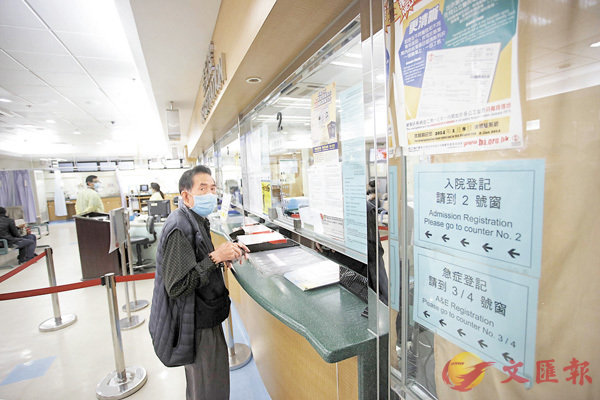 ■急症室大幅加價外,還須配合公私醫療合作、中產稅務優惠等措施,才可有效減輕公營醫療壓力。 資料圖片
■急症室大幅加價外,還須配合公私醫療合作、中產稅務優惠等措施,才可有效減輕公營醫療壓力。 資料圖片【原文】公立醫院多項服務6月18日起加價,其中急症室(Accident and Emergency services)收費由原價100港元加至180港元。急症室等公營醫療服務加價,主要目的是希望分流(diversion)病人,紓緩公營醫療的壓力,但效果如何尚待觀察。
根據以住經驗,急症室加價短期(short-term)可能抑制需求。長遠而言,市民對公營醫療的依賴(dependent)仍難以改變。
短期需求料減
資料顯示,公營急症室收費自2002年底加至100港元後,2003年求診人次迅速下跌23.2%。2004年開始,求診人次逐漸回升(resurged),2015/16年急症室總求診人次比2002年加價前的水平只少了6%。
由此可見,急症室加價短期內或有一時效果,但由於公營服務的收費遠低於私營服務,當市民習慣(adapt to)急症室的新收費後,需求很大機會逐漸回升(bounce back)。
公私合作加減稅利分流
公營醫療系統承擔照顧基層市民的社會責任,不可能大幅加價。因此,要分流病人、減輕急症室及公營醫療系統的壓力,必須加強公私醫療合作(public-private partnership)。
例如,醫管局推行的「普通科門診公私營協作計劃」,參加計劃的病人可從實行計劃的16區中,自選1名參加計劃的私家醫生作為家庭醫生,每名病人每年可獲最多10次資助診症(subsidised visits),只需繳付普通科門診收費。
計劃為病人提供更多、更方便的基層醫療服務,建立持續的醫生與病人關係(patient-doctor relationships),又紓緩對公立醫療服務的需求,一舉兩得(kills two birds with one stone)。
推自願醫保 招外地人才
對於收入較高的中產人士,政府可參考外國的經驗,以稅務優惠(tax concessions)或津貼作為誘因,吸引其轉為使用私營醫療服務;政府還應加快落實自願醫保計劃(Voluntary Health Insurance Scheme),積極與私營醫療機構、保險界協商,制訂保費合理的(reasonable )、可持續的(sustainable )醫保計劃。
要保障本港醫療服務的質素,醫護人力資源(manpower)是關鍵,偏偏本港醫療服務供應最大的局限,正是醫護人手不足。政府日前公佈檢視醫療人手的報告顯示,本港醫護人手短缺的情況將持續(persist)。單靠本港自己培養、返聘退休醫護人員,解決不了人手不足的難題。在做好監管、保證質素的前提下(premise),政府應考慮放寬外地醫生來港執業的限制。 (標題及小標題為編輯所加) (摘錄自香港文匯報社評19-6-2017)
Charge rises in A&E services work only in short term
【譯文】Public hospital fees were raised from June 18 to encourage diversion of less urgent patients and alleviate pressure on the public healthcare system. Among the public healthcare that saw price increases were Accident and Emergency (A&E) services-which jumped from HK$100 to HK$180 after hikes.
However, the outcomes of this new measure remain to be seen. Observations on past experience suggest that fall in A&E services demand might only be short-term, as the populace is still very much dependent on the public health sector.
Short-term demand could drop
According to the statistics, A&E attendance plunged as much as 23.2 per cent in 2003, after the charge was increased to HK$100 at the end of 2002. Attendance gradually resurged since 2004 however, and by 2015/16 the number of patients was only six per cent less when compared to pre-2002 level. Apparently, price hikes in A&E services may temporarily curb demand, which is set to bounce back when patients adapt to new fees due to the fact that it is still much more affordable than private clinics.
More ways to divert patients
As the public healthcare sector serves as an essential safety net for the general public, a substantial increase in charges is unthinkable. Therefore, public-private partnership must be strengthened in order to ease the strain on emergency rooms.
Take the Hospital Authority's General Outpatient Clinic Public-Private Partnership (GOPC PPP) Programme as an example: patients can choose one private doctor from the list of participating service providers in the 16 districts as their family doctor. Each patient may receive up to 10 subsidised visits per year, and would only need to pay the fees of a general outpatient clinic.
The programme kills two birds with one stone-not only does it foster long-term patient-doctor relationships while offering more choices and convenience for patients seeking primary healthcare services, it also helps to manage demand for public healthcare services.
Expedite the VHIS
As for the middle-income group, the government may refer to overseas experience and encourage diversion to the private sector with tax concessions or other subsidies. It should also step up its efforts in negotiating a reasonable and sustainable deal with the private healthcare sector and the insurance industry, so as to expedite the implementation of the Voluntary Health Insurance Scheme (VHIS).
Medical manpower is a crucial factor to the quality of Hong Kong's healthcare, yet the health sector is now facing a critical manpower shortage. According to the government's staffing review, shortfall in doctors and nurses is going to persist. Dependence on locally-trained medics and re-employment of the retired would hardly be enough to fill the gap.
Under the premise of sound supervision and quality assurance, the government should consider relaxing limitations on recruiting non-local professionals.■Jeffrey Tse [ywc_jeffrey@hotmail.com]
Exercise
1. 執業醫生
2. 內科醫生
3. 外科醫生
4. 藥劑師
5. 門診病人
Answers
1. practitioner
2. internist/physician
3. surgeon
4. pharmacist
5. outpatient

